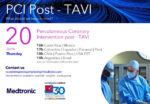At present, most percutaneous coronary intervention procedures (PCI) are done with drug eluting stents (DES). However, drug coated balloons (DCB) have shown benefits in restenosis and small vessel de novo lesions. Intravascular ultrasound (IVUS) has been shown effective in left main PCI and complex procedures, even though there is little infomration on its use for...
06/20 | SOLACI Webinar: Post-TAVI percutaneous coronary intervention. Register now
A new virtual educational event organized by the Latin American Society of Interventional Cardiology with the support of Medtronic is approaching. On this occasion, we will hold a 90-minute event on Post PCI – TAVI with renowned Latin American specialists and the presence of Dr. Gilbert Tang (USA). Consult the scientific agenda and register. The...
Grieving for the Loss of José Pepe Uribe
On behalf of the Latin American Society of Interventional Cardiology (SOLACI), we extend our deepest heartfelt condolences for the passing of T. José Pepe Uribe (México) former Director of the Nurses and Technicians Chapter from 2015 to 2017. The board of directors here at SOLACI joins colleagues, friends and family in this time of grief....
Patients with CABG History and new N-ST ACS: Routine Invasive Strategy?
Multiple studies support the use of an early invasive approach in high risk patients with non-ST elevation acute coronary syndrome (NST ACS). This benefit of an invasive strategy over the expected management has been shown in randomized studies and meta-analysis. Patients with a history of cardiac artery bypass graft (CABG) represent approximately 10% of ACS...
Low-Flow Aortic Stenosis: What is the Value of Valve Calcification in its Interpretation?
Delays in the treatment of symptomatic aortic stenosis (AS) reduce prognosis, especially in elderly patients. Accurate assessment of AS severity is crucial to avoid overtreatment and its associated risks. A transthoracic echocardiogram (TTE) is the initial evaluation in the diagnostic algorithm, and severity values are well established. However, some patients may obtain discordant data due...
Long Term Outcomes of Hyperemic Stenosis Resistance Index (HSR) in Patients with Stable Chronic Angina
The hyperemic stenosis resistance index (HSR) was introduced as a more complete hemodynamic severity indicator of a coronary lesion. HSR combines both pressure drop across a lesion and the flow through it, therefore overcoming the limitations of traditional indices such as fractional flow reserve (FFR) and coronary flow reserve (CFR). The aim of this multicenter...
BIONYX: Onyx vs. Orsiro At 5 Years
Onyx is a zotarolimus-eluting stent (ZES), designed with thin struts and a platinum core that enhances its radiological visibility. This can be beneficial in complex situations with limited visibility, such as in patients who are obese or present severe calcification, two particularly frequent characteristics in diabetic or elderly patients. The BIONYX study was a randomized...
Pre-Catheterization Fast
It has been generally established that coronary procedures with local anesthesia and moderate sedation minimally require a 6 hour fast for solids and 2 hours for liquids (according to SCAI guidelines 2021). However, complications requiring emergency orotracheal intubation are extremely rare. Prolonged fasting can have adverse effects such as hypoglycemia, insulin resistance, acute renal failure...
CART Technique for Chronic Total Occlusions
The retrograde technique has significantly improved the success of percutaneous treatment of chronic total occlusions (CTO). After crossing a collateral channel, creating a connection between the anterograde and retrograde systems is key. The most common technique for this is reverse controlled antegrade and retrograde subintimal tracking (reverse CART). This technique involves inflating a balloon over...
Microvascular Resistant Reserve: Impact on STEMI Patients
Coronary Microvascular Dysfunction (CMD) is being increasingly considered a common consequence of STEMI. Its presence partly explains the persistence of angina symptoms in over 50% of patients after PCI, despite successful epicardial artery reperfusion. Also, CMD has been independently associated with worse left ventricular ejection fraction recovery, which leads to worse prognosis, including recurrent events,...









